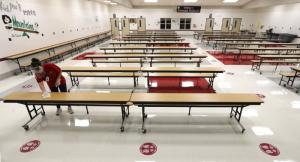Health expert: Mayors have a critical role to play in school reopening

Mayors may not control the schools in every city, but most are still feeling the political heat of one of the most complex decisions related to COVID-19: whether, when, and how to bring students back for in-person instruction.
It’s a question that has only grown more complicated and contentious as infection rates grow across much of the U.S. According to an Education Week sampling of 281 school systems, about 38 percent — and 9 out of the 15 largest districts — are now planning to reopen with remote instruction only. Another 28 percent say they’ll fully reopen for in-person instruction, 13 percent are planning a mix of virtual and school-based learning, and 21 percent are undecided.
To help mayors and other city leaders navigate the choices ahead, Dr. Joshua Sharfstein of the Johns Hopkins Bloomberg School of Public Health yesterday led a conversation with hundreds of mayors and other city leaders as part of the Bloomberg Philanthropies COVID-19 Local Response Initiative. There’s a path to reopening schools safely — and a big role for mayors to play, Sharfstein said — but it requires getting community spread of the novel coronavirus under control first.
It’s a critical issue to figure out, and not just for educational reasons. About 20 million kids get breakfast and lunch at school, and one-fifth of all child abuse reports come in through school monitoring. There are social and emotional benefits to in-person learning, as well as benefits to working parents who struggle to hold down jobs while their kids stay home. The downsides of schools staying closed are falling most heavily on women and communities of color.
The evidence shows that younger children are at lower risk than adults in being infected by coronavirus, and much lower risk of becoming seriously ill from it, Sharfstein said. It’s probably the case that younger children transmit the virus somewhat less than adults do, he said, but there’s still a substantial risk. At the same time, one fifth of teachers and a third of principals are over the age of 55, and many others have underlying conditions that put them at high risk.
Sharfstein pointed to the examples of Austria, Norway, and Germany as a sign that schools can reopen without becoming a major source of infections. They were successful because they started from a low point in terms of community spread and took precautions such as keeping kids safely distanced and grouped in small cohorts. He also cited Israel as a cautionary tale, where scaling back restrictions resulted in outbreaks.
“There’s reason to believe there’s a pathway here,” Sharfstein said. “You wait for the community spread to come down and then you open with precautions.”
While many communities aren’t ready for that yet — “there’s a tremendous amount of virus out there,” Sharfstein said — there are four things mayors can do to get schools ready for returning to in-person learning.
Advocate for resources. To reopen safely, schools will need more space, more personnel, more transportation options, good access to testing, the ability to communicate and engage with parents, teachers, and the community, and more. With Congress considering making relief funds available for schools, Sharfstein said, “this is a moment to really explain how important that is.”
Help prioritize. Younger students, children receiving special services, or those whose parents have no choice but to go to work will benefit most from going back to in-person school. Where schools are only able to partially reopen, mayors can advocate for those students. “This is a situation where just treating every child exactly the same is not the right answer for equity,” Sharfstein said. “You have to help the kids who need in-person schooling the most.”
Act as a bridge between the schools and health systems. After four months of becoming public-health experts, mayors may be well positioned to plug school systems into resources they need. Take COVID testing. While Sharfstein said schools shouldn’t try to test every teacher and student, they will need good access to testing in order to prevent a few infections from turning into major outbreaks. “Making sure that the school system has access to the testing it needs is something the mayor could be very helpful with,” he said.
Take one step at a time. As has been the case nearly every day since the pandemic began, the situation is evolving quickly. Whatever plan schools land on to start the new year can be updated as things on the ground change, for better or for worse. “Where we start isn’t necessarily where we end,” Sharfstein said. “We’re going to learn an enormous amount about what’s safe and what isn’t. Developing a process and flexibility to be able to revisit some of these decisions in the school year is going to be important.”


